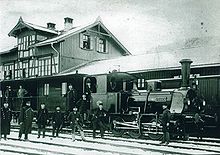LAG No. 5 to 8
| LAG No. 5 to 8 | |
|---|---|
|
FEET
|
|
| Number: | 4th |
| Manufacturer: | Krauss & Cie , Munich and Linz |
| Year of construction (s): | 1889 |
| Axis formula : | C. |
| Length over buffers: | 7,508 mm |
| Service mass: | 6.73 Mp |
| Top speed: | 30 km / h |
| Indexed performance : | 150 PSi |
| Coupling wheel diameter: | 1,317 mm |
| Impeller diameter: | 915 mm |
| Cylinder diameter: | 250 mm |
| Piston stroke: | 580 mm |
| Boiler overpressure: | 10 kgf / cm² |
| Grate area: | 0.83 m² |
| Evaporation heating surface: | 18.20 m² |
| Locomotive brake: | mechan. Handbrake |
The locomotives with the numbers 5 to 8 were built in 1889 by the locomotive factory Krauss & Cie, Munich & Linz for the Lokalbahn Aktien-Gesellschaft (LAG). The under No. 2051 built FEET involved in the LAG, the no. 7 was, the oldest operable standard gauge steam locomotive in Germany.
history
In 1889 the LAG procured four three-axle steam locomotives for the Marktoberdorf – Füssen local railway , which were the only LAG locomotives to have names as well as numbers 5 to 8: NEUSCHWANSTEIN, HOHENSCHWANGAU, FÜSSEN and SÄULING. Since from 1901 on the Marktoberdorf – Füssen route, more powerful locomotives, u. a. the no. 17 and 19 were used were reacted locomotives to other LAG-paths, 5 and 8 to the local railway Sonthofen-Oberstdorf , 6 (HOHENSCHWANGAU) for Forster City rail (it was sold to the city timber 1920 with the) . No. 6 remained there until the Forster city railway was discontinued in 1966 and was then sold to the Dubring gravel works near Wittichen for their connecting railway, which existed until 1972.
The number 7 was taken over in 1901 in the operation of the local railway Fürth-Cadolzburg , where it finally proved to be too weak for longer trains. That is why the FÜSSEN was finally moved to Upper Swabia in 1911 and was used on the newly opened Niederbiegen – Weingarten and Baienfurt line from then on .
In 1928 it was sold as a factory locomotive to the Baienfurt paper mill (later Feldmühle , then Stora Enso Baienfurt GmbH), which was a member of this freight railway.
By the deadline in August 2019, it was the oldest operational standard-gauge steam locomotive in Germany and has been in regular use since 2002 as a loan to the Bavarian Railway Museum (BEM) in Nördlingen , from which it was acquired in 2009.
Constructive features
The third axis is the driving axis. The frame is designed as a water tank, the coal is carried in front of the driver's cab next to the boiler.
Except for the throw lever brake, the machine has no braking device.
photos
Web links
- Steam locomotives of the Bavarian Railway Museum. Feet. Bavarian Railway Museum, archived from the original on November 5, 2013 ; accessed on December 12, 2017 (pictures of the feet).
Individual evidence
- ↑ Gerd Wolff: German small and private railways. Volume 7: Bavaria . EK-Verlag, Freiburg 2002, ISBN 3-88255-666-8 , p. 246, 282 .
- ↑ Locomotive No. 6. In: Die Schwarze Jule - Eine Eisenbahnlegende. THD, accessed June 24, 2018 .
- ↑ http://www.merte.de/BE/archiv/02997-01.htm , accessed on August 19, 2011; Klaus Jünemann, Erich Preuß: Narrow-gauge railways between the Spree and Neisse . Transpress VEB Verlag for Transport, Berlin 1988, ISBN 3-344-00307-0 , p. 32
- ↑ 120-year-old FÜSSEN stays in Nördlingen . In: Railway magazine . No. 6 , 2009, p. 20 .




